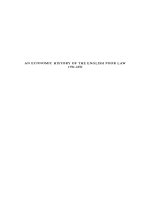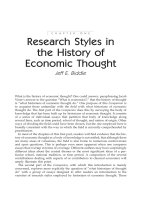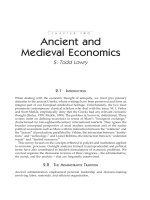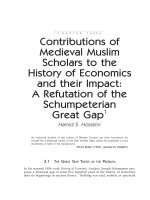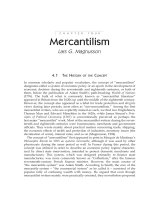Vulnerable planet a short economic history of environment
Bạn đang xem bản rút gọn của tài liệu. Xem và tải ngay bản đầy đủ của tài liệu tại đây (3.45 MB, 169 trang )
the
vulnerable
planet
a short e co no mi c history of the environment
John Bellamy Foster
THE VULNERABLE
PLANET
THE VULNERABLE
PLANET
A Short Economic History of
the Environment
JOHN BELLAMY FOSTER
¿CORNERSTONE
MONTHLY REVIEW PRESS
NEW YORK
Copyright © 1999 by John Bellamy Foster
All rights reserved
Library o f Congress Cataloging-in-Publication Data
Foster, John Bellamy.
The vulnerable planet: a short economic history
o f the environm ent / by John Bellamy Foster. — [Rev. ed.]
p. cm.
Includes bibliographical references and index.
ISBN 1-58367-019-X (paper)
1. Environm ental degradation. 2. Environmental policy. I. Title.
GE140.F68 1999
363.7— dc21
Monthly Review Press
146 West 29th Street Suite 6W
New York, NY 10001
Manufactured in Canada
10 9
99-38834
CIP
CONTENTS
PREFACE
7
1. THE ECOLOGICAL CRISIS
II
2. ECOLOGICAL CONDITIONS
BEFORE THE INDUSTRIAL REVOLUTION
34
3. THE ENVIRONMENT AT THE TIME
OF THE INDUSTRIAL REVOLUTION
SO
4. EXPANSION AND CONSERVATION
69
5. IMPERIALISM AND ECOLOGY
85
6. THE VULNERABLE PLANET
108
6
CONTENTS
7. THE SOCIALIZATION OF NATURE
125
AFTERWORD
143
NOTES
151
INDEX
165
PREFACE
I was slow in comm itting myself fully to the environmental
cause. I grew up in the 1950s and 1960s in the Pacific Northwest
of the United States, an area known for the quality o f its environ
ment. During the first Earth Day in April 1970 I was a fairly
complacent participant. It was natural, I thought, that those
living in L.A. or along the Great Lakes should be disturbed by the
destruction of the environment. But in the Northwest we were as
yet comparatively free from such worries. My chief concern at
that time was the Vietnam War. As long as napalm was being used
on the people of Indochina, the issue of the health of the envi
ronm ent seemed an unaffordable luxury.
From the mid-1970s to the mid-1980s the most im portant
questions seemed to m e to be those of economic crisis and third
world underdevelopment. As a public intellectual in the Reagan
era, my efforts were devoted primarily to resisting the attem pt by
the powers that be to shift the burden of economic stagnation
7
8
THE VULNERABLE PLANET
onto the backs of workers, the unemployed, women, people of
color, and the m ajority o f the w orld’s population in the third
world. For me, as for Raymond W illiams, “resistance to capi
talism ” had become the “the decisive form o f the necessary
hum an defense.” But unlike W illiams I did n ot yet fully appre
ciate the connection between this and the fate of the earth
itself.1
It was my return to the Pacific Northwest in 1985, after almost
a decade’s absence, that finally forced me to open my eyes to the
full global dimensions of the ecological crisis. “Every middleaged man who revisits his birthplace after a few years of absence,”
New England environmentalist George Perkins Marsh observed
in 1847, “looks upon another landscape.” Marsh, then in his
mid-forties, was alarmed by the cycles of destruction that he had
witnessed over his own lifetime in his native Vermont. The
devastation of hillsides, the burning of the woods, the damming
of streams represented changes “too striking,” he wrote, “to have
escaped the attention of any observing person.”2
In returning to the Northwest in the mid-1980s, I discovered
that a region that had been known for the pristine character of
much of its environm ent was now facing the prospect of massive,
irreversible ecological destruction— of global, not simply re
gional, proportions. The old-growth coniferous forest, contain
ing many of the world’s oldest and tallest trees, was being cut
down at a record rate; the Columbia-Snake River system had
become one of the most threatened river systems in the country;
and num erous species, from the northern spotted owl to the
Snake River salmon, were endangered. The Hanford nuclear
facility in the state of W ashington was revealed to be one of the
world’s worst sources of radioactive contamination. Everywhere
a war was raging between environmentalists and the forces of
economic expansion.
The late 1980s were also years in which world awareness of the
threats posed by global warming, destruction of the ozone layer,
tropical deforestation, and the extinction of species rose dramat-
PRÉFACE
9
Unbeatable oil waste stored in barrels at an oil-waste treatment
center in Bahia, Brazil. [Katherine McGlynn/lmpact Visuals]
ically. The combined effect of these influences compelled me to
face up to the growing dangers to the planet.
Yet for all of this new ecological awareness, the social concerns
of my youth were by no means lessened. There is a very real sense
in which those who have devoted their energies to overcoming
social inequality have always been involved in the battle for
environm ental justice. W ar, economic inequality, and third
world underdevelopm ent— the three phenom ena that drew
most of my attention in the decades of the 1970s and 1980s— are
inextricably bound to the larger question of the systematic deg
radation of the planet and of the conditions of life for a majority
10
THE VULNERABLE PLANET
o f the world’s people. The failure to perceive this connection is
the principal weakness of mainstream environmentalism. If we
are to make sense of the environmental crisis, we must not
abandon radical social concerns but broaden and deepen them
to take into account the destruction of the earth itself. It is above
all the interconnectedness o f social and environmental problems
that constitutes the prim ary basis upon which a potent move
m ent for change can be created.
My intellectual and personal debts in the writing of this book
are many. Among those who have directly or indirectly given
support to this work, I would like to m ention Michael Dawson,
Susan Lowes, Paul Sweezy, Harry Magdoff, James O ’Connor, Art
MacEwan, Bill Tabb, Mike Tanzer, Bob McChesney, Patrick
Novotny, David Milton, Nancy Milton, Ellen Meiksins W ood,
Neal W ood, Edward Goldsmith, Greg McLauchlan, Sandy As
hton, Dave Ashton, Bill Foster, Linda Berentsen, Eileen Merritt,
Charles H unt, Kathy H unt, and Laura Tamkin. The Vulnerable
Planet itself is dedicated to Saul, whose all-embracing love of the
earth and of hum anity in the third year of his life has helped
sustain within me an ecological politics of hope without which
this work would not have been possible.
7
THE ECOLOGICAL CRISIS
Hum an society has reached a critical threshold in its relation
to its environment. The destruction of the planet, in the sense of
making it unusable for hum an purposes, has grown to such an
extent that it now threatens the continuation of much of nature,
as well as the survival and development of society itself. The litany
of ecological complaints plaguing the world today encompasses
a long list of urgent problems. These include: overpopulation,
destruction of the ozone layer, global warming, extinction of
species, loss of genetic diversity, acid rain, nuclear contam ina
tion, tropical deforestation, the elimination of climax forests,
wetland destruction, soil erosion, desertification, floods, famine,
the despoliation of lakes, streams, and rivers, the drawii.g down
and contamination of ground water, the pollution of coastal
waters and estuaries, the destruction of coral reefs, oil spills,
overfishing, expanding landfills, toxic wastes, the poisonous ef
fects of insecticides and herbicides, exposure to hazards on the job,
ri
12
THE VULNERABLE PLANET
urban congestion, and the depletion of nonrenewable resources.
According to the prestigious Worldwatch Institute, we have only
four decades left in which to gain control over our major envi
ronmental problems if we are to avoid irreversible socio-ecological decline, and the 1990s are the critical decade in which the
necessary changes must begin to occur.1
Yet most current prescriptions for solving the planet’s ecologi
cal problems are woefully inadequate to meet such ominous
threats, since they am ount to little more than calls for new
international agreements, for personal restraint with regard to
the growth of both population and consumption, and the adop
tion of a handful of so-called environmentally friendly technolo
gies. In what follows I will argue that we m ust begin by
recognizing that the crisis of the earth is not a crisis of nature but
a crisis o f society. The chief causes of the environmental destruc
tion that faces us today are not biological, or the product of
individual hum an choice. They are social and historical, rooted
in the productive relations, technological imperatives, and his
torically conditioned demographic trends that characterize the
dom inant social system. Hence, what is ignored or downplayed
in most proposals to remedy the environmental crisis is the most
critical challenge o f all: the need to transform the major social
bases of environmental degradation, and not simply to tinker
with its m inor technical bases. As long as prevailing social rela
tions remain unquestioned, those who are concerned about what
is happening are left with few visible avenues for environmental
action other than purely personal commitments to recycling and
green shopping, socially untenable choices between jobs and the
environment, or broad appeals to corporations, political policy
makers, and the scientific establishment—the very interests most
responsible for the current ecological mess. In other words,
because the crisis has social roots, the solution must involve the
transform ation o f historical relationships on a global scale in
order to fashion a sustainable relationship between nature and
society.
THE ECOLOGICAL CRISIS
13
THE GROWTH OF THE WORLD ECONOMY
History teaches us that societies have long been at war with the
environment, treating nature as little more than a resource to be
tapped and as a sink into which to dum p their wastes. At times
such a one-sided exploitation of nature has led to regional envi
ronmental catastrophes that have in turn led to the fall of whole
civilizations— the Sumerians are one example that will be dis
cussed in detail later. Nevertheless, until the last few centuries
hum an society existed on so small a scale in relation to the global
environment that its effects remained fairly negligible.
This situation began to change with the emergence, in stages,
of the capitalist world system, which began in Europe in the late
1400s. The great h isto ric a l tra n sfo rm a tio n in itia ted by
Columbus’ voyage across the Atlantic five hundred years ago
marked the origins of what was to become the capitalist world
system and the simultaneous creation o f a world hierarchy o f
nation states, defined by the relation of colonizer and colonized,
more developed and less developed. The European colonization
of the greater part of the globe, beginning with the “New W orld”
and extending to the Asian and African continents, led to the
extraction of vast quantities o f economic surplus— whether in
the form of precious metals, such as gold and silver, or agricul
tural products, such as sugar, spices, coffee, tea, and m any
more— and therefore to the social and ecological transform ation
of the colonized regions. “The gold and silver of the New W orld,”
the great' French historian Fernand Braudel wrote, “enabled
Europe to live above its means, to invest above its savings.”2The
rise o f m odern colonialism was thus a crucial force behind the
commercial revolution experienced by European society from
the sixteenth through the eighteenth centuries. Additional
sources of food, such as maize, potatoes, and num erous varieties
of beans— all of which originated in the Americas— were taken
back to Europe, transforming European agriculture and then the
agriculture of the entire world. All of this helped prepare the way
for the next great stage of capitalism’s advance, the Industrial
14
THE VULNERABLE PLANET
Revolution, which took place in Europe in the late eighteenth and
early nineteenth centuries and led to a rapid increase in the scale
and intensity of production and to the development of a set of
divisions that are at the core of our understanding of the m odern
world: the division between economy and nature, between capital
and labor, and between center and periphery.
The impact of these developments on the planet’s environ
m ent becomes clear when we examine changes in four key
areas— population, energy, industrialization, and urbaniza
tion— over the last four centuries.
Population
At the time of Colum bus’ first voyage in 1492 the Americas
were the home, according to the most recent estimates, of some
100 million people— compared to a European population o f only
about 70 million (in 1500). Epidemics and the violence of the
conquest led to the rapid decimation of the indigenous Amerind
ian populations and to the “demographic takeover” of their land
by peoples o f European origin. “Wherever the European has
trod,” Charles Darwin observed, “death seems to pursue the
aboriginal.” W ithin a century after 1492, the indigenous popula
tion had dropped by 90 percent.
This demographic takeover of m uch o f the world by people of
European origin was facilitated by a population explosion in early
capitalist Europe that was the result o f a sharp decline in death
rates. This decline was in turn mainly due to the beneficial effects
of improved nutrition and sanitation, which reduced famines
and epidemics. In England and Wales, the home of the Industrial
Revolution, the population was 6 million in 1750. It had in
creased by half, to 9 million, in 1800. In the next fifty years it
doubled, to 18 million. After this, the rate o f population growth
declined, although the population continued to rise— to 33 mil
lion in 1900. And the increase took place even though Britain
exported 20 million people from the sixteenth century through
THE ECOLOGICAL CRISIS
15
the early twentieth century (Europe exported 60 million over the
same period). As a result of the population explosion at home
and expansion abroad, Europeans and their overseas offspring
increased their share of world population from about 18 percent
in 1650 to more than 30 percent in 1900.3
This European population explosion tapered off in the twen
tieth century. In Europe, as in all regions that have reached fairly
advanced stages of economic development, birth rates— re
sponding to higher levels of affluence— eventually fell, producing
population growth rates close to replacement level, in the final
phase of what is known as the “demographic transition.” One of
the key characteristics of development, the demographic transi
tion is the gradual changeover from a demographic equilibrium
of high death rates and high birth rates, characteristic of pre
industrial society, to a demographic equilibrium o f low death
rates and low birth rates, characteristic of the more developed
industrial societies. In the first phase of the transition, associated
with early industrialization, there is a decline in the death rate
that is not matched by a corresponding decline in the birth
rate— and therefore a population explosion. In the second phase,
economic development leads to a drop in the birth rate as well,
slowing down the rate o f population growth. Thus the population
of the developed world expanded rapidly in the eighteenth and
nineteenth centuries but slowed in the twentieth. By 1985, net
population growth in the industrialized countries had dropped
to 0.4 percent per year.4 Affluence thus resulted in lower popu
lation growth rates, which then tended to reinforce the affluence.
In contrast, the countries on the periphery of the world econ
omy were unable to follow the same path— to industrialize and
then complete the demographic transition. Instead they found
their development hindered by the legacy of colonialism and by
the need to compete with the advanced capitalist economies, on
terms set by the latter. The “development of underdevelopment,”
as this situation came to be called, was marked by a continual
outflow o f surplus from the peripheral countries to the core
16
THE VULNERABLE PLANET
countries, rather than the development of the periphery itself.
This resulted in a gap in per capita income between core and
periphery that increased sevenfold over the course of a little more
than two centuries (we will discuss this further below). The “lag”
between the decline in the mortality rate (associated with the
move toward industrialization) and the fall in the fertility rate
(associated with im proved living standards) has thus been
lengthened for countries at the bottom o f the global economic
hierarchy. Caught in a demographic trap between an “industrial”
death rate and an “agricultural” birth rate, many underdeveloped
countries are faced with an unenviable situation: their popula
tions are growing rapidly while their rates of economic growth
per capita are stagnant or declining, each o f which then reinforces
the other. W hat has happened, according to the renowned envi
ronmentalist Barry Commoner, is that it kind o f “demographic
parasitism” has developed, in which “the second, populationbalancing phase of the demographic transition” in the affluent
center of the capitalist world economy “is fed by the suppression
of the same phase” in the impoverished periphery. “Colonial
ism,” Com m oner writes, “has determined the distribution of
both the world’s wealth and of its hum an population, accumu
lating most of the wealth north of the equator and most of the
people below it.”5
The main consequence of the inability o f the periphery to
develop economically and complete the demographic transition
is that the weight of hum an numbers has become a growing
ecological problem. W orld population increased from around
500 million in 1600 to more than 750 million in 1750,1.25 billion
in 1850,2.5 billion in 1950, and 5.5 billion today— an increase of
1,000 percent since 1600. It is expected to exceed 8 billion by the
year 2020. And 95 percent of the projected increase will occur in
the underdeveloped periphery.
To be sure, the rate of population growth is now decreasing
because some industrializing countries— such as China, Thai
land, and South Korea— have begun to experience the drop in
THE ECOLOGICAL CRISIS
IT
An overcrowded urban area in Indonesia contrasts with the modern
office towers in the distance. [Sean Sprague/Impact Visuals ]
the birth rate that defines the second phase o f the demographic
transition. Nevertheless, the world’s population continues to rise
and the ability to stabilize it will depend more than anything else
on the speed with which the underdeveloped nations are able to
reach replacement-level fertility. Long-term United Nations pro
jections suggest that such stabilization will happen when popu
lation reaches around 10 billion in 2095, but only if fertility in the
periphery (particularly South Asia, Africa, and Latin America)
drops to replacement-level by 2035. If replacement-level fertility
is not reached until 2065, however, the world population would
be 14 billion in 2100. And even this could turn out to be optim is
ia
the v u ln e r a b le p la n e t
tic if there is not further substantive economic development in
the periphery, and hence the possibility of completing the second
phase of demographic transition in those countries now experi
encing a population explosion.6
Energy
The Industrial Revolution was accompanied by a revolution in
the conversion of inanimate energy to meet hum an needs. As the
pathbreaking U.S. environmental philosopher and historian
Lewis M umford observed in his Technics and Civilization (1934),
this was part o f a m ore general shift in the “technological com
plex” of civilization from the “ecotechnic phase,” based on a
“water-and-wood complex,” to the “paleotechnic phase,” based
on a “coal-and-iron complex.” The growing scarcity of firewood
from the sixteenth century on helped spur the demand for coal,
and coal production in England rose from 200,000 tons in the
mid-sixteenth century to 3 million tons at the end of the seven
teenth. This in turn generated the demand for better mine en
gines, as shafts had to be sunk deeper and deeper below the water
table. In the second half of the eighteenth century, James W att
perfected previous innovations and built a steam engine that was
widely adopted. It was powered by coal and was at first used
primarily in coal mining, but was later used in the textile and
metallurgical industries and the railroads. “Coal,” British econ
omist W.S. Jevons wrote in 1865, “stands not beside but entirely
above all other commodities. It is the material energy of the
country, the universal aid, the factor in everything we do. W ith
coal almost any feat is possible or easy; without it we are thrown
back into the laborious poverty of early times.” W orld coal
production in 1800 am ounted to about 15 million tons per year.
By 1860 it had risen to around 132 million tons and by 1900 to
701 million (a 46-fold increase over the course of the century).
In the last third of the nineteenth century oil and natural gas
began to be exploited, electrical generators were introduced, and
THE ECOLOGICAL CRISIS
19
giant hydroelectric projects were built. World consumption of
petroleum grew rapidly, from 10 million tons in 1890 (shortly after
the introduction of the first automobiles) to 95 million tons in 1920,
294 million tons in 1940, and 2.5 billion tons a year in the 1970s.
Industrialization was thus associated with the consumption of non
renewable fossil fuels (coal, petroleum and natural gas), supple
mented by hydroelectric (and later nuclear) power.
But even as more energy was being produced, more was being
sought. World consumption of commercial energy— most of it
from nonrenewable sources— rose over 60 times between 1860
and 1985. Moreover, global energy consumption patterns re
flected the widening division of the world economy between core
and periphery. The average N orth American today uses 40 times
the amount of commercial energy used by the average person in
the third world. Energy consumption per person in the advanced
capitalist countries is 80 times that in sub-Saharan Africa.7
Industrialization
Behind these changes in population and energy use lay the
fundamental changes in production that are associated with
industrialization and the development o f capitalism. The Indus
trial Revolution was dom inated in its initial phase (1760-1840)
by the rise of the cotton mill in Britain and in its second phase
(1840-1875) by the growing use of the steam engine, particularly
in the development of the railroad. The next stage (sometimes
known as the scientific-technical revolution) began in the late
1800s and involved the development of the steel, chemical, and
electricity industries, followed, as the twentieth, century ap
proached, by the rise of the automobile. Finally, the second half
o f the twentieth century saw the growth of petrochemicals, the
development of jet aircraft, and the emergence of computers.
Transformations in the division o f labor were closely related
to each of these changes, progressing from a system of “simple
management” under the competitive capitalism of the first In
20
THE VULNERABLE PLANET
dustrial Revolution, to “scientific management” (called Taylor
ism after its founder Frederick Taylor) under the monopoly
capitalism of the scientific-technical revolution, and finally to
growing reliance on what is often called “flexible, interchange
able” manufacture under the increasingly globalized production
of the present day.
In the context of these changes in production, world manufac
turing output (including handicrafts) rose dramatically, increas
ing more than 80 times between 1750 and 1980 (an estimate that
takes into account the effects of the destruction of third world
handicraft production during the eighteenth and nineteenth cen
turies). As recently as 1950, the world m anufactured only oneseventh the goods that it produces today and extracted only
one-third the minerals. Although the rate of growth has slowed
since the 1970s, the world economy continues to expand expo
nentially: it took only the two decades from 1970 to 1990, when
the growth rate o f world industrial production was 3.3 percent,
for total industrial output to double. W ith a 3 percent rate of
growth, world production will double every 23 years. W ith a 4
percent rate of growth, it will double every 18 years.8
Such exponential growth has been accompanied by growing
problems o f distribution, both within countries and between
center and periphery. In about 1750, per capita income in what
are now the developed countries and what are now the underde
veloped countries was roughly equal: about $ 180 (in 1960 dollars
and prices) in the former and between $ 180 and $ 190 in the latter.
But by about 1930, per capita income in the developed countries
had risen to $780 (again in 1960 dollars and prices), while in the
underdeveloped countries it had remained at the 1750 level of
$190. In 1980, the gap had widened still further, with the devel
oped countries reaching a per capita income of $3,000 and the
underdeveloped countries $410. Over the entire period of capi
talist development, therefore, the gap between center and periph
ery grew from 1:1 in 1750 to 4:1 in 1930 to 7:1 in 1980. All o f this,
in the words o f economist Robert Heilbroner, reflects “cumula
THE ECOLOGICAL CRISIS
21
tive tendencies toward strength at the Center to which surplus is
siphoned, and weakness in the Periphery from which it is ex
tracted.” Seventy-five percent of world production is now ab
sorbed by the 25 percent o f the world’s population living in the
industrial countries.9
Urbanization
Before 1800 the world was overwhelmingly rural, with no more
than 2.5 percent of the population living in cities. The first nation
to have a level of urbanization above 10 percent was the N ether
lands, beginning in the early sixteenth century. The next was
Britain. By 1800 London was the largest city in Europe with a
population of more than 850,000. By 1985, 43 percent of the
world’s population was urbanized— although this num ber re
flected wide discrepancies, with urbanization in N orth America
and Europe (excluding the USSR) at 64 and 55 percent respec
tively, and that of Latin America, East Asia, South Asia, and Africa
at 41,17, 16, and 15 percent respectively.
Large urban agglomerations have environmental effects at
three levels: locally, regionally, and globally. Locally, the topog
raphy is altered and replaced by a “built environm ent” of brick,
concrete, glass, and metal on, above, and below the ground.
Regionally, artificial heat is generated. Cities over 250,000 be
come “heat islands,” hotter than the surrounding countryside (a
city of 10 million may have a mean annual m inim um tem pera
ture as much as.4°F higher than its rural periphery). Globally,
these urban areas contribute to atmospheric problems, such as
the emission of sulfur and large quantities of carbon dioxide—the
latter of which is believed to contribute to global warming.10
The greater the division of an economy into urban and rural
areas, the greater the spatial concentration o f population and
industry, leading to concentrated— and therefore more harm
ful— forms of pollution. Moreover, what economists call the
logic of “uneven and combined development”— the unevenness
22
THE VULNERABLE PLANET
or inequality between regions, together with their combination
into a single international division of labor— means that the
worst effects of pollution are experienced in third world cities and
export enclaves. Air pollution levels are higher in cities in the
periphery (or semi-periphery)— such as Bangkok, Bombay, Bue
nos Aires, Cairo, Calcutta, Manila, Mexico City, Rio de Janeiro,
São Paulo, Seoul, and Tehran— than in most of the advanced
capitalist world. For instance, the highest allowed ozone level, as
set by international standards, is 100 points. O n February 6,1992,
Mexico City’s ozone level was 342 points and on March 16 it rose
to 398 points. Factories were ordered to cut production and
schools were closed. In the late 1980s, only 8 of India’s 3,119
towns and cities had full sewage treatm ent facilities and not more
than 209 had partial treatm ent facilities.
Industry-led urban development is accompanied by the spread
of “reductionist agriculture” in rural areas, where the capital-intensive and energy-intensive application of hybrid seeds, chemi
cal fertilizers, pesticides, and farm machinery produces cash
crops primarily for export. This leads at first to rapid growth in
agricultural productivity, but it also creates crops that are increas
ingly dependent on ever higher, m ore costly, and less efficient
doses of fertilizers and pesticides. Meanwhile, subsistence agri
culture is pushed onto marginal or less productive land, leading
to deforestation and soil erosion. Among the worst cases is Haiti,
where an impoverished population is struggling to survive on
deforested m ountain slopes while multinational agribusinesses
own the most fertile land in the valleys below.11
THE HUMAN TRANSFORMATION OF THE EARTH
The hum an transform ation o f the earth has reached a point
that is unprecedented in the scale, rate, and kind o f environmen
tal change, the cumulative result of the uneven economic devel
opm ent o f the last four centuries. This transformation of the
earth has reached the point at which there is increasing likelihood
THE ECOLOGICAL CRISIS
23
of overshooting critical thresholds associated with the finite na
ture of the ecosphere, with disastrous results for life on earth.
The concept of critical thresholds, as Donella Meadows, Dennis
Meadows and Jorgen Randers, the authors of the landm ark
ecological study Beyond the Limits, tell us, can be best understood
if production is conceived as being made up o f a physical “flow
or throughput {тот the planetary sources of materials and energy
through the hum an economy, to the planetary sinks where waste
and pollutants end up.” This is in accord with the first and second
laws o f thermodynamics, which tell us that m atter and energy
cannot be used up but only transformed; that energy dissipates
into unusable heat; and that materials cannot be recycled 100
percent.12 Put simply, the problem is that many of the crucial
sources for the streams o f energy and materials that feed hum an
society and production are declining, while m any of the sinks are
overflowing. Renewable sources of energy, including cultivable
land, water, forests, and the world’s species, are all being ex
ploited at rates that raise questions about sustainability.
At present the world has more food than is needed to feed the
world’s population. Hunger exists not because of physical lim i
tations but because of the way food is produced and distributed.
As the population increases, however, the physical limitations to
food production may become increasingly important. For in
stance, there are definite limits to the am ount of potentially
cultivable land, estimates of which vary between 2 and 4 billion
hectares (depending upon what is considered cultivable), with
1.5 billion hectares already under cultivation and land erosion
further reducing the total. Between 1970 and 1990, the world’s
deserts expanded by about 120 million hectares, more than the
amount of land currently cultivated in China. In the years 19701990, an estimated 480 billion tons o f topsoil was lost, an am ount
about equal to India’s entire cropland. The capacity to increase
agricultural yields on available land, meanwhile, may be limited
by the reliance on agricultural chemicals— pesticides and fertil
izers— in most m odern agriculture (a problem that will be dis
24
THE VULNERABLE PLANET
cussed later) and by the need for water. It is possible that con
straints on agriculture will become critical as the population
again doubles part way through the next century. W ater is a key
consideration in all of this: demand has been rising faster than
availability. “Globally water is in great excess, but because of
operational limits and pollution,” the authors o f Beyond the
Limits argue, “it can in fact support at most one more doubling
of demand, which will occur in 20 to 30 years.”13
Besides being a source of forest-based products, forests form
soil, moderate climate, limit floods, and store water against
drought. They hold soil on slopes, preventing erosion. They are
hom e to most of the world’s species. By taking in and holding
carbon, forests stabilize the stock of carbon dioxide in the atm o
sphere, thereby combatting the greenhouse effect (discussed
below). It is therefore significant that half of the world’s forest
loss over the course of hum an history occurred between 1950 and
1990. In the fragile ecosystems of the world’s tropical forests—
where 50 percent of the world’s species reside— half of the forest
cover is now gone and half of what remains is fragmented and
degraded. Even if cutting down tropical forests was limited to a
constant 2 percent of the remaining forest per year, which would
lead to a smaller and smaller am ount cut, it has been estimated
that most of the remaining tropical forests would be gone after a
century. If the tropical forests are cut down at the same rate at
which population is growing in tropical countries, they will be
gone in thirty years.
The extinction of species, according to estimates provided by
biologist Edward O. Wilson, one of the world’s leading experts
on biodiversity, is now occurring at the staggering rate of 27,000
species a year— 74 every day, 3 every hour. Wilson estimates that
up to 20 percent of the world’s species could become extinct over
the next three decades, a level of extinction not experienced since
the disappearance of the dinosaurs 65 million years ago. It has
been estimated that there may be 30 million species alive in the
world today, only a small proportion of which— 1.4 million—
